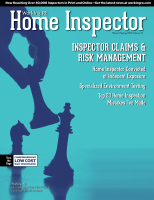 | > E&O/GL Insurance for Home Inspectors Competitive Rates, Broad Coverage, Free Risk Management, online inspection support for tough questions, discounts on education and more… Professional Coverage, Competitive Pricing Shop OREP today! |
Infrared Camera and Home Inspections
by Bill Fabian, Monroe Infrared Technology
Infrared cameras (IR) have been steadily gaining popularity with home inspectors for more than 10 years now. Partly because inspectors want to provide a more thorough inspection and ideally add more revenue to their business. It is also because the next generation of home buyers are more technically savvy and expect the use of all available technology for their prospective home’s inspection.
Infrared cameras have been used for industrial and commercial inspections for over 50 years with the primary application being electrical systems. Today, many commercial insurance companies require an annual infrared safety inspection of electrical systems for their insured clients because history has proven that no other inspection is as effective at reducing the risk of electrical fires and related injuries.
Why Infrared?
IR allows home inspectors to “see” issues that are not visible to the naked eye. Infrared also can confirm potential issues that are only partially identified like staining, deformation, etc. Simply put, infrared will make you a more efficient, effective, productive, and profitable home inspector. Do you want to differentiate, charge more, grow your revenue and company?
Water Issues: The #1 find for home inspectors is locating hidden water leaks. There may be no visual signs, but, if the conditions are right, the presence of water will stick out like a sore thumb with an IR camera! We can’t live without it but water is very damaging to homes (See Figure 1).
Safety Issues: From a safety perspective, every home inspector should be looking at the electrical system. As a past student, Bradley Scott, said, “If you don’t look at anything else, look at the electrical system. It is not a matter of if, it is a matter of when you save someone’s life.” Do everything you can to keep your clients safe from harm (See Figure 2).
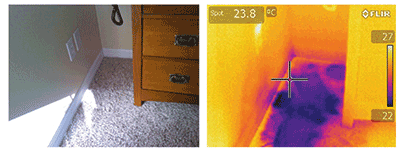
Figure 1: Water Damage in Flooring
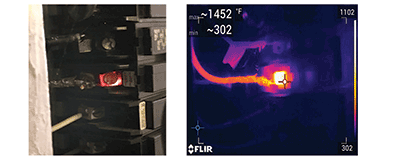
Figure 2: Faulty Electrical Panel
(story continues below)
(story continues)
Energy Loss Issues: With steady and substantial material cost increases over the years and especially in the last 2 years, understanding the conditions of the insulation, or more importantly locating areas with “NO INSULATION” is an extreme benefit to home buyers. Missing insulation can not only can make a home very warm or very cold/drafty, it increases the homeowners energy bill substantially while prematurely wearing out mechanical parts with unnecessary extra runtime (See Figure 3).
Pest Infestations: While infrared is NOT like an x-ray, warm blooded animals, termites, rodents, bees and other creatures often create a thermal difference that a professional home inspector’s infrared camera will detect. A bees nest in the wall can be nearly impossible to detect or termites eating through the joists of a deck. (Note the dark lines on the bottom of the deck joists are termites inside the wood). What you don’t see could hurt or sting your client! (See Figures 4 and 5).
These are just a few of the applications home inspectors check for every day with their infrared cameras.
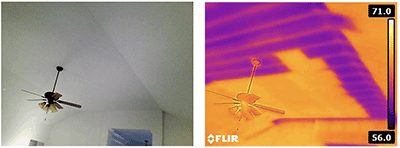
Figure 3: Missing Insulation
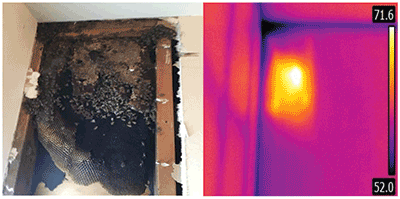
Figure 4: Bees Nest in Wall
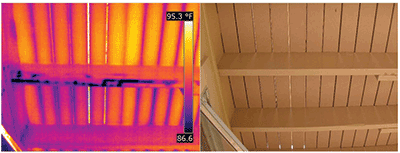
Figure 5: Termites in Fence
There are so many applications for infrared cameras to be used as part of a home inspection including solar panels, water temperatures, stucco, EIFS, roof leaks, radiant heating systems, duct leakage, air infiltration, pool pumps, forced air distribution (supplies & returns), and many more.
What Infrared Camera Should a Home Inspector Use?
The major IR Camera manufacturers in the home inspection market today are Teledyne FLIR and HIKMicrotech (or HIK for short). This competition among manufacturers for market share has resulted in professional infrared cameras which are easy to use, offer amazing application support features that were never available for less than $8,000 to $10,000 even just a few years ago.
Infrared cameras designed for consumers start at about $400. Experienced home inspectors do their homework and opt for professional tools when selecting an infrared camera. Though the underlying science of heat transfer is the same, the better you are in using infrared, the more confidence you will have in your findings.
Regardless of the infrared camera you decide to incorporate into your home inspections, make sure to invest in yourself with Infrared Certification Training to use it properly and maximize your ROI. Competent, confident IR-certified home inspectors report increasing revenues by 10% to 20% offering infrared.
If you are a home buyer or realtor looking for a professional home inspector who is trained, certified and offering the proper use of infrared in a pre-buy or pre-sale home inspection, go to https://monroeinfrared.com/infrared-training/graduate-locator/ and put in your zip code for a listing of certified infrared home inspectors in your area.
About the Author
Bill Fabian is a Level III Master Thermographer and Vice President of Monroe Infrared Technology. Bill designed Monroe Infrared’s two-day Certified Residential Thermographer (CRT) Class which includes over 2300 home inspector graduates all across the USA and part of Canada. Reach Bill at (800) 221-0163 or by email at training@monroeinfrared.com.
OREP Insurance Services, LLC. Calif. License #0K99465


